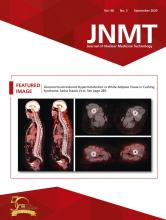Tina M. Buehner, MS, CNMT, NMTCB(CT)(RS), RT(N)(CT)
Every president has an agenda; that is why we run for office. We want to improve the profession and believe that we can, in fact, do so. Ensuring alignment between presidential goals and the strategic plan that supports the SNMMI-TS mission and vision is essential to fostering a prosperous year of achievements and organizational success.
The SNMMI-TS mission is to improve human health by advancing technology and professionals in nuclear medicine and molecular imaging. Our vision is to ensure that nuclear medicine and molecular imaging are an integral part of the standard of care for patient diagnosis, treatment, and therapy. The strategic plan for achieving our vision incorporates outcome-oriented goals focused on ensuring organizational strength and stability to advance and support the profession, demonstrating quality, value, and safety in nuclear medicine and molecular imaging procedures and advocating for the profession and our professionals.
As the new SNMMI-TS president, I am passionate about elevating the profession of nuclear medicine technology. To me, “elevation” of the profession is a multifaceted goal involving three very separate but interconnected concepts: education, community, and professional recognition.
Education is not limited to ensuring the technical competency of the nuclear medicine technologist (NMT). It involves developing and enhancing effective communication skills. It involves developing the overall individual by enhancing skill in critical thinking and clinical reasoning and maximizing autonomy within their scope of practice. It involves creating a professional who is a lifelong learner so they can meet the demands of a rapidly changing, complex health-care environment with continuous technological advances. To ensure that educational standards appropriately reflect the increasing knowledge and skill required of the NMT, this year the SNMMI-TS Education Committee, under the direction of Cybil Nielsen, MBA, CNMT, FSNMMI-TS, will be performing a comprehensive curriculum revision. Additionally, I have formed a task force for competency-based assessments for adjunctive medications that will focus on creating resources for members who want to verify competency among staff who administer adjunctive medications in conjunction with nuclear medicine procedures and therapies (CCK, Lasix, amino acids, etc.).
I believe that strengthening professional and interprofessional communities also is central in elevating our profession. The Technologist Section, together with our chapters, has done a fantastic job with advocacy and educational outreach on the local and national levels. Moreover, advancements in technology and communication have offered us the opportunity to globalize the practice of nuclear medicine technology. This allows for continued development of best practices across demographic and cultural boundaries, as well as increasing collaboration on education and research to continue moving the profession forward. Similarly, building interprofessional alliances with other medical imaging societies will promote a comprehensive partnership in the medical imaging community from which all colleagues and members can benefit. To foster those collaborations, I am looking forward to hosting the Nuclear Medicine Technologist Global Initiative Meeting that was postponed this year due to COVID-19. This international meeting—to be held in Washington, DC, in 2021—will be a collaborative effort of NMT leaders from around the globe connecting to discuss all issues related to the profession and to identify partnership opportunities for the future.
Lastly, I understand and respect the criticality of professional recognition in the elevation of our profession. Professional recognition is defined as “the formal acknowledgement of an individual’s professional status and the right to practice in accordance with professional standards and subject to professional or regulatory controls” (1). As health-care professionals we are seen from many different perspectives, including those of our patients, our own colleagues, the general public, other health-care practitioners, state and institutional bodies, and the federal government. SNMMI has developed exceptional resources for patients, the general public, and referring providers, including the DiscoverMI.org informational website on who we are, what we do, and what to expect during NM procedures; appropriate use criteria (AUC) and best practice guidelines for referring providers and colleagues; and more. Additionally, the SNMMI-TS Continuing Education Committee has created a plethora of continuing education opportunities and learning activities that allow the NMT to prepare for advanced certifications, which increase professional recognition within the medical imaging community. This year I plan to work closely with our membership and staff to continue promoting professional recognition of the profession and the professional.
I do not think any of us could have imagined the magnitude of change that COVID-19 brought into our world. The methods we utilize to work, learn, teach, worship, socialize, celebrate, and collaborate have all been radically transformed for our safety and for the safety of others. While I do not know exactly what our future will be post-COVID, one thing that I have learned over the past two decades is that we are a resilient profession, and as such we will prevail and come through stronger than ever.
REFERENCE
- 1.↵








